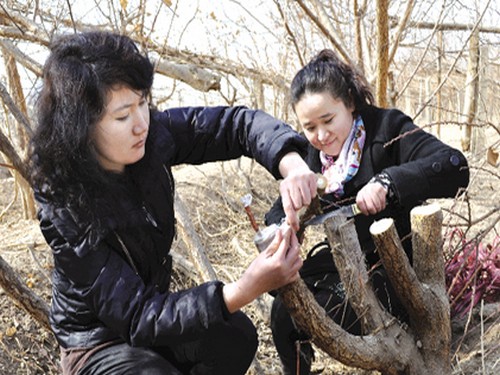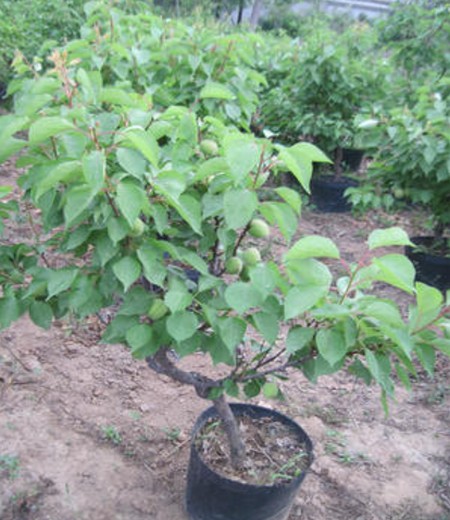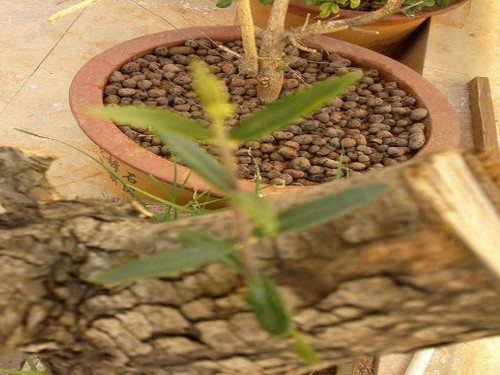Grafting technique of apricot tree
In recent years, with the promotion of the hot air drying house drying project of apricot in the three prefectures of southern Xinjiang, people in southern Xinjiang have become more and more enthusiastic about planting apricot trees. The villagers of Suyitika village, who have planted apricot trees for many years, are also seizing this opportunity to vigorously develop the apricot industry, but the villagers are in urgent need of apricot grafting technology, and they want to know what precautions and taboos there are in grafting. Zhang Ping, a researcher at the Institute of Agricultural products Storage and processing of the Academy of Agricultural Sciences, told the editor that due to the strong adaptability of apricot trees and low requirements for cultivation conditions, grafting of fine varieties is indispensable to increase yield.

[choice of grafting]
The mature apricot tree with pure variety, good quality and strong growth should be selected as the ear-picking mother tree for grafting. Grafting can be carried out before the sap begins to flow to blossom and foliage in spring, but the optimum period is that the rootstock buds begin to sprout to blossom, and early grafting will affect the survival rate of high grafting.
[method of grafting]
Skin grafting is suitable for thicker rootstocks. The specific operation steps are as follows: select the smooth part of the branch on the rootstock, saw off the rootstock, and cut off the saw stubble with a knife. Two to four cuttings were selected according to the thickness of the rootstock, and then a small opening was cut downward along the cuttage point on the cortex of the rootstock, the depth was half of the thickness of the cortex, and the length should be less than the cutting surface of the scion. After the scion is taken out and soaked, a slope with a length of 3 cm to 5 cm is cut at the lower end of the scion, the edges on each side of the cutting surface are cut off a little skin, and the lower part of the opposite side of the cutting surface is cut by a small slope. Finally, leave 2 to 3 buds from above the long noodles and cut off the scion. Insert a smooth bamboo stick between the phloem and xylem at the cutting point, gently insert it along a small opening outside the cortex, pull out the bamboo stick, press the scion against the xylem of the rootstock, and insert it along the gap until the cutting surface is only about 0.5 cm. This is beneficial to the healing of the rootstock. When inserting a scion, the upper end of the scion should be tilted slightly outward, so that the lower end of the cutting surface should always be inserted close to the woody part of the rootstock, so as to prevent the lower part of the scion from penetrating into the rootstock cortex. After receiving, fasten the scion and rootstock with plastic strip, seal the wound of the rootstock with wet mud or plastic, and then cover the plastic bag, which should be 3 cm to 5 cm higher than the scion.
Splicing is often used for height grafting of young and big trees. Cut off the rootstock in a smooth part of the skin and split the rootstock from the middle with a splitter knife, 3 cm to 4 cm deep. At the lower end of the scion, a bevel is cut from each side, and the edges on both sides of the slope are slightly thinner on one side and thicker on the other, showing a flat wedge shape, leaving 2 to 4 buds on the scion. Open the split of the rootstock, put the thinner side of the scion inward, the thicker side outward, and gently insert it, so deep as to expose about 0.5 cm above the cutting surface of the scion.
"the management should be strengthened after grafting, otherwise the effect will be affected. After being connected, one should be watered in time, combined with irrigation and topdressing, and the fertilizer should be mainly nitrogen fertilizer. After 10 days to 20 days to check the survival situation, did not survive in time to pick up. " Zhang Ping stressed.
In addition, in order to improve the survival rate of apricot grafting, the following technical points should be mastered in the process of grafting.
[cultivate rootstocks]
Seedlings used for grafting should be watered, weeded and sprouted in time to cultivate dominant tree trunks. Generally used for grafting rootstock seedlings require a ground diameter of 2.5-3 cm. Seedlings bred with seeds can be grafted in the second year, and seedlings planted in the field can be grafted in the second year after planting.
[storage scion]
Apricot scions are generally collected from the same year's branches, requiring the female parent to be strong, free from diseases and insect pests and full buds. Ear harvesting is collected before bud germination and stored in a cool bunker or vegetable cellar after branch picking. The size of the bunker depends on the number and length of the branches, one layer of sand on one layer of branches and one layer of sand on the other. When it is 20 cm above the ground, cover it with wet sand. Vegetable kiln storage is relatively simple, directly a layer of branches and a layer of wet sand buried on the line. The storage time is at least one week. The scion can be picked and picked in summer.
[grafting period]
The selection of grafting period is directly related to the survival rate of graft. under different temperature conditions, the growth rate of cells is different, so the wound healing rate is also different, which affects the survival rate of grafting and the growth of seedlings after survival. The time is too early, the temperature is low, the rootstock cambium cells just begin to sprout, the healing tissue grows slowly, and the grafting wound is not easy to heal; high temperature grafting in summer, too high temperature or too much water loss in the bag will also affect the movement of rootstock cambium cells. The suitable time for grafting in Heshuo area is March 25 to April 10, March 5 to April 1 must be bagged, and April grafting does not need bagging. The budding period can be carried out from mid-July to early September. Budding requires that the cambium of the scion is in an active growth state, the buds and rootstocks are easy to peel off and survive after grafting.
[grafting operation]
The advantages and disadvantages of grafting technology are shown in the smoothness of the cutting surface of the interface and the speed of grafting. The cutting surface is not smooth or the cambium of the rootstock is not aligned, so that the cambium of the rootstock can not be in close contact, the wound healing speed will slow down or can not heal, even if the healing will also affect the growth of the scion, the occurrence of late germination, weak growth, easy to split and so on. When grafting, the surface of the scion should be trimmed, the rootstock and the cambium of the scion should be aligned, and the plastic strips should be tightly wrapped to ensure a firm interface. To improve the speed of grafting, it is required to be quick in knife, bud cutting, rootstock cutting and binding, so as to reduce the time of bud grafting and rootstock exposure to air, avoid air drying of cutting surface or oxidation of cambium, reduce water evaporation, and maintain a water film on the surface of the wound. it can promote the formation of callus. Split grafting, tongue grafting and so on are often used in spring, and T-shaped bud grafting is often used in bud marriage.
[post-management]
1. After the apricot tree is grafted, it should be watered in time to ensure the water supply of the scion.
2. According to the growth speed of the stem, untie it in time to ensure the nutrient supply of apricot trees.
3. Wipe buds and remove sprouting at any time so as not to cause excessive loss of nutrients and affect the growth of grafted seedlings.
4. When the new branches growing on the scion are about 20 cm long, measures should be taken to fix the branches to prevent them from being broken by the wind.
5. Cut off the dense and delicate twigs to facilitate the ventilation and light of the tree. The cultivated tree shape is beneficial to the hanging fruit of apricot trees.
Time: 2019-05-25 Click:
- Prev

Planting methods and matters needing attention of apricot trees
Apricot fruit ripens early, has high nutritional value, is suitable for processing and raw food, and occupies an important position in the early spring fruit market. From the domestic and foreign markets in the past ten years, apricot fruit is in short supply, the price is rising steadily, and the economic benefit is high, so it is a promising tree species. Apricot is one of the main fruit tree varieties in southern Xinjiang.
- Next

Cultivation techniques of Robinia pseudoacacia
Robinia pseudoacacia wood is hard and resistant to moisture. Can be used for pillars, sleepers, vehicles, agricultural materials, leaves containing crude protein, is a good feed for many livestock, flowers are excellent nectar plants, Robinia pseudoacacia honey color white and transparent, welcomed by consumers, tender leaves are edible, has become a green vegetable for urban residents
Related
- Fuxing push coffee new agricultural production and marketing class: lack of small-scale processing plants
- Jujube rice field leisure farm deep ploughing Yilan for five years to create a space for organic food and play
- Nongyu Farm-A trial of organic papaya for brave women with advanced technology
- Four points for attention in the prevention and control of diseases and insect pests of edible fungi
- How to add nutrient solution to Edible Fungi
- Is there any good way to control edible fungus mites?
- Open Inoculation Technology of Edible Fungi
- Is there any clever way to use fertilizer for edible fungus in winter?
- What agents are used to kill the pathogens of edible fungi in the mushroom shed?
- Rapid drying of Edible Fungi

